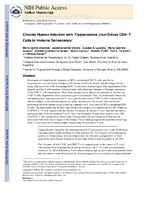Please use this identifier to cite or link to this item:
http://sgc.anlis.gob.ar/handle/123456789/1485| DC Field | Value | Language |
|---|---|---|
| dc.contributor.author | Albareda, María Cecilia | en_US |
| dc.contributor.author | Olivera, Gabriela Carina | en_US |
| dc.contributor.author | Laucella, Susana A. | en_US |
| dc.contributor.author | Alvarez, María Gabriela | en_US |
| dc.contributor.author | Fernandez, Esteban Rodrigo | en_US |
| dc.contributor.author | Lococo, Bruno | en_US |
| dc.contributor.author | Viotti, Rodolfo | en_US |
| dc.contributor.author | Tarleton, Rick L | en_US |
| dc.contributor.author | Postan, Miriam | en_US |
| dc.date.accessioned | 2019-12-09T20:36:22Z | - |
| dc.date.available | 2019-12-09T20:36:22Z | - |
| dc.date.issued | 2009-09-15 | - |
| dc.identifier.uri | http://sgc.anlis.gob.ar/handle/123456789/1485 | - |
| dc.description.abstract | Previously we found that the frequency of IFN-gamma-producing CD8(+) T cells specific for Trypanosoma cruzi inversely correlates with disease severity in chronic human Chagas disease along with low levels of IL-2-secreting CD8(+) T cells in all clinical stages. This impairment of the parasite-specific T cell responses was associated with phenotypic features of immune senescence of the CD8(+) T cell compartment. These data prompted us to address the question of whether the CD4(+) T cell compartment also experiences signs of exhaustion. Thus, we performed a functional and phenotypical characterization of T. cruzi-specific and overall CD4(+) T cells in chronically infected subjects with different degrees of cardiac dysfunction. The results show an inverse association between disease severity and the frequency of T. cruzi-specific IFN-gamma-producing CD4(+) T cells. The high expression of CD27 and CD28 with a relative low expression of CD57 found on CD4(+)IFN-gamma(+) T cells suggests that the effector T cell pool in chronic T. cruzi infection includes a high proportion of newly recruited T cells, but a low frequency of long-term memory cells. The total CD4(+) T cell compartment shows signs of senescence and later stages of differentiation associated with more severe stages of the disease. These findings support the hypothesis that long-term T. cruzi infection in humans might exhaust long-lived memory T cells. | en_US |
| dc.language.iso | en | en_US |
| dc.relation.ispartof | Journal of immunology (Baltimore, Md. : 1950) | en_US |
| dc.title | Chronic human infection with Trypanosoma cruzi drives CD4+ T cells to immune senescence | en_US |
| dc.type | Artículo | en_US |
| dc.identifier.doi | 10.4049/jimmunol.0900852 | - |
| item.cerifentitytype | Publications | - |
| item.fulltext | With Fulltext | - |
| item.openairetype | Artículo | - |
| item.openairecristype | http://purl.org/coar/resource_type/c_18cf | - |
| item.grantfulltext | open | - |
| item.languageiso639-1 | en | - |
| crisitem.author.dept | Administración Nacional de Laboratorios e Institutos de Salud “Dr. Carlos G. Malbrán” (ANLIS) | - |
| crisitem.author.dept | Instituto Nacional de Parasitología (INP) | - |
| crisitem.author.parentorg | Administración Nacional de Laboratorios e Institutos de Salud “Dr. Carlos G. Malbrán” (ANLIS) | - |
| Appears in Collections: | Publicaciones INP | |
Files in This Item:
| File | Description | Size | Format | |
|---|---|---|---|---|
| nihms184858.pdf | Artículo en inglés | 791.05 kB | Adobe PDF |  View/Open |
Page view(s)
139
checked on Dec 24, 2025
Download(s)
29
checked on Dec 24, 2025
Google ScholarTM
Check
Altmetric
Altmetric
Items in DSpace are protected by copyright, with all rights reserved, unless otherwise indicated.

